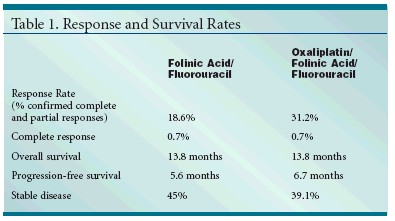Oxaliplatin Added to First-Line Therapy Increases Response in Metastatic CRC
This special “annual highlights” supplement to Oncology News International (ONI)is a compilation of selected news on important advances in the management ofgastrointestinal cancers over the past year, as reported in ONI. Guest Editor, Dr.James L. Abbruzzese, comments on the reports included herein and discussesdevelopments in the clinical management of GI cancers, with a look at the impactof targeted agents with cytotoxic chemotherapy, first-line and adjuvant therapies foradvanced disease, and the role of statins and COX-2 inhibitors in prevention.
GRONINGEN, The Netherlands-Oxaliplatin (Eloxatin) addedto a standard bolus fluorouracil/folinicacid (5-FU/FA) regimen apparentlyincreases response and progressionfreesurvival time in patients with metastaticcolorectal cancer (abstract3539), according to data presented atthe 2004 Annual Meeting of the AmericanSociety of Clinical Oncology.The oxaliplatin-containing combinationwas associated with less grade3-4 diarrhea and mucositis vs 5-FU/FA in the randomized, phase III trial.Median overall survival time was approximately14 months in patientstreated with standard therapy or withthe regimen containing oxaliplatin."Despite a low treatment cross-overrate, overall survival in both groupswas comparable," according to theDutch Oxaliplatin Study Group. Reportingon behalf of the group wereGeke Hospers, MD, PhD, UniversityHospital Groningen, and MichaelSchaapveld, MD, ComprehensiveCancer Center North Netherlands,Groningen, Netherlands.Compared to Standard TxThe study included 302 patientswith metastatic colorectal cancer enrolledbetween July 1999 and August2002. As first-line treatment, patientsreceived either:
- standard bolus administrationof 5-FU 425 mg/m2 on days 1 to 5, andFA 20 mg/m2 on days 1 to 5 q4 wk; or
- oxaliplatin 85 mg/m2 as a 2-hourinfusion, FA 200 mg/m2 as a 1-hourinfusion, and 5-FU 2,600 mg/m2 as a24-hour infusion on day 1 q2wk.
Courses were continued until diseaseprogression. The median numberof courses received was six for 5-FU/FA and eight for oxaliplatin/5-FU/FA.The median age of patients in theDutch study was 63 years (range, 28-80 years) and about 60% were male.Close to 95% of patients had a WorldHealth Organization (WHO) performancescore of 0 to 1. The primary siteof disease was the colon in 75% ofpatients and the rectum in about 25%.About 10% of patients had previousadjuvant treatment.Data presented at ASCO representeda median follow-up of 13.2 months,with 18% of patients still alive. Responsewas confirmed in 31.2% of pa-tients on oxaliplatin/5-FU/FA, but inonly 18.6% of the standard therapyarm. Overall survival time was 13.8months in both arms, according toDr. Hospers and Dr. Schaapveld. Progression-free survival time was longerin the oxaliplatin/5-FU/FA arm (6.7months vs 5.6 months,
P
< .01). Rates of stable disease were 39.1% and 45%,respectively (see Table 1).
Grade 3-4 Toxicities Differ
Stomatitis/diarrhea was much morecommon in the standard 5-FU/FAarm, 22 cases vs 6 cases in the oxaliplatin/5-FU/FA arm (
P
< .001). Therewas a low (less than 10%) incidence ofgrade 3-4 vomiting and hematologictoxicity in both groups. Grade 3/4 sensoryneuropathy, related to oxaliplatin,was seen in 10% of patients in theoxaliplatin/5-FU/FA arm. There wasone toxic death, from septicemia, inthe standard 5-FU/FA arm.

"Immunologic side effects deserveattention," the investigators noted. Inthe oxaliplatin arm, 5% had grade 3-4immunologic events; two cases wereclassical anaphylaxis and five wereatypical, with thrombocytopenia,hemolysis, pulmonary and renal dysfunction,and the one toxic death.Second-line treatment was notspecified in the study protocol, butabout 14% of patients on standardtherapy crossed over to treatment withoxaliplatin. Overall, about 60% of patientsin either arm went on to receivesecond-line treatment.